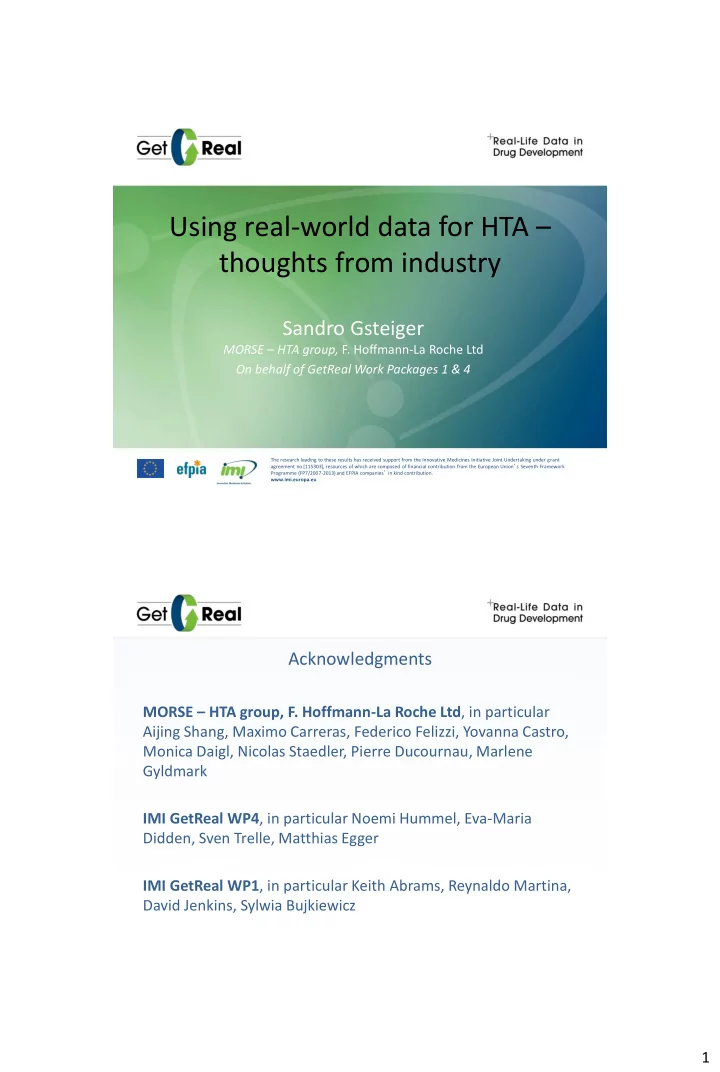

Using real-world data for HTA – thoughts from industry Sandro Gsteiger MORSE – HTA group, F. Hoffmann-La Roche Ltd On behalf of GetReal Work Packages 1 & 4 The research leading to these results has received support from the Innovative Medicines Initiative Joint Undertaking under grant agreement no [115303], resources of which are composed of financial contribution from the European Union ’ s Seventh Framework Programme (FP7/2007-2013) and EFPIA companies ’ in kind contribution. www.imi.europa.eu Acknowledgments MORSE – HTA group, F. Hoffmann-La Roche Ltd , in particular Aijing Shang, Maximo Carreras, Federico Felizzi, Yovanna Castro, Monica Daigl, Nicolas Staedler, Pierre Ducournau, Marlene Gyldmark IMI GetReal WP4 , in particular Noemi Hummel, Eva-Maria Didden, Sven Trelle, Matthias Egger IMI GetReal WP1 , in particular Keith Abrams, Reynaldo Martina, David Jenkins, Sylwia Bujkiewicz 1
RWE – another “big data” movement in pharma Broad interest to leverage RWE across all development stages development early • Incidence / Prevalence estimates • Define target product profile (TPP) • Understand drug use/treatment patterns development • Background mortality late • Long-term effects Benchmarks & extrapolation • Heterogeneous patient (time and “space”) populations HTA Bridge knowledge gaps in NMA with RWD RCTs • Bridge gaps A D • Use all evidence C RWD B E ? • Data availability B E – Most uncertainty around new compound – RWD on new compound will RCTs + RWD not be available at time of A D decision making C • How to weight RWD? B E 2
Weighting: compare discounting of historical data – how much can we learn from RCTs on a new trial? Ref. Appl. Total Eff. % y 1 θ 1 n n “use” historical trials y 2 θ 2 Neuenschwander Transplantation 930 90 10% et al (2010) … µ y H θ H Neuenschwander Ulcerative 363 22 6% et al (2010) collitis ? new trial Gsteiger et al MS 1936 45 2% y * θ * (2013) Gsteiger et al MS 412 63 15% Exchangeable information (2013) from RCTs Baeten el al AS 533 43 8% (2013) Massive discounting needed with historical controls (exchangeable!). Expect even more discounting from (non-exchangeable) RWD? NMA with combinded RCT + RWD: sensitivity analysis giving different weights α to RWD Power prior model: P( θ |RCT, RWD) ∝ L(RCT| θ ) ⋅ L(RWD| θ ) α ⋅ P( θ ) Use grid of (fixed) values α Source: K. Abrams. MORSE Academy 2015. 3
Extrapolation • Benchmarks from registries • Blending of short-term RCT with long-term RWD • “Anchoring” predictions with registry estimate [Cf Abrams et al. WP1] Particularly interesting in adaptive pathways context • Extrapolation (short/mid-term) • Monitoring • Validation Are these methods acceptable for decision makers? “This new method is a black - box to me. I would not accept it.” “I do not understand this. I could end up being so confused that I would not be willing to take any decision at all!” [Statements from regulators at IMI GetReal WP1 workshop] … unless you can explain the method really well. … unless you can “fully” establish the properties of the method. … unless the method is well accepted in the literature. “Take NMA as an example: initially a lot of skepticism, but now a standard (in some countries)!” 4
Some final remarks • RWD valuable, but not the only source to inform effectiveness Theory Disease progression models Exposure-response models RWD • Not forget about the local level – RWD: inevitably a “local reality” … – Initiatives: EAMS (UK), AIFA mandated registries (IT) • Predictions: adopt mindset including validation • Populations: we should systematically share individual patient baseline characteristics from our trials! References Dominique Baeten et al., “Anti -Interleukin-17A Monoclonal Antibody Secukinumab in Treatment of Ankylosing Spondylitis: A Randomised, Double-Blind, Placebo- Controlled Trial,” The Lancet 382, no. 9906 (November 29, 2013): 1705 – 13, doi:10.1016/S0140-6736(13)61134-4. D. Jenkins et al, Including Real World Evidence (RWE) in network meta-analysis; ISCB 36 th Annual Conference, Utrecht 23-27 August, 2015 R. Martina et al, The inclusion of real world evidence (RWE) in clinical development planning; ISCB 36th Annual Conference, Utrecht 23-27 August, 2015 B. Neuenschwander et al., “Summarizing Historical Information on Controls in Clinical Trials,” Clin Trials 7, no. 1 (February 2010): 5 – 18, doi:10.1177/1740774509356002. S. Gsteiger et al., “Using Historical Control Information for the Design and Analysis of Clinical Trials with Overdispersed Count Data,” Stat Med 32 (May 31, 2013): 3609 – 22, doi:10.1002/sim.5851. Susanne Schmitz, Roisin Adams, and Cathal Walsh, “Incorporating Data from Various Trial Designs into a Mixed Treatment Comparison Model,” Statistics in Medicine 32, no. 17 (2013): 2935 – 49, doi:10.1002/sim.5764. Kert Viele et al., “Use of Historical Control Data for Assessing Treatment Effects in Clinical Trials,” Pharmaceutical Statistics 13, no. 1 (January 1, 2014): 41 – 54, doi:10.1002/pst.1589. 5
Recommend
More recommend